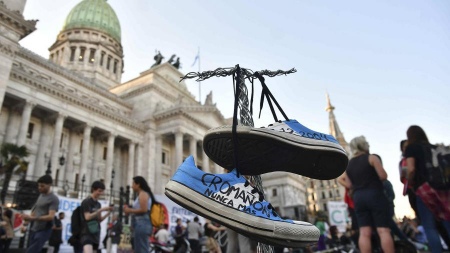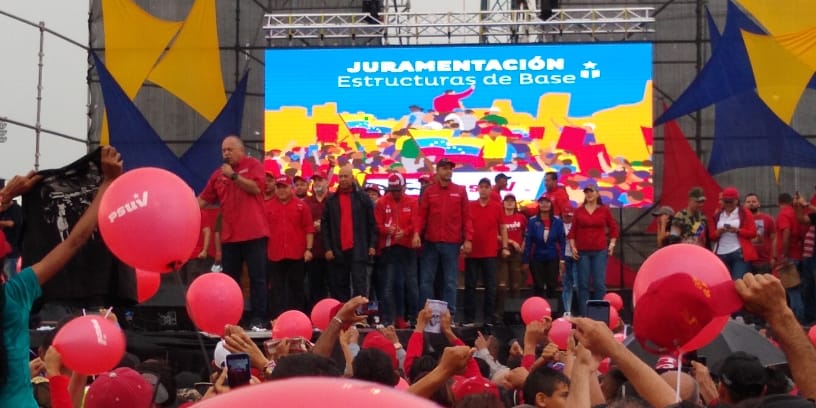The Balvanera dance venue in which 194 people died from a fire during a recital in 2004 will become a space for memoryaccording to a law approved this Thursday night in the Senate, on which survivors and relatives of the victims of the “Cromañón” massacre considered that it will serve to “pay off a debt with society.”
The norm obtained 60 votes in favor and one against during a special session to declare the property located at Bartolomé Miter 3038/78, where the Republica Cromañón bowling alley operated, to be used as “public utility and subject to expropriation” “to the creation of a space dedicated to the memory of what happened on December 30, 2004”.
The repair initiative has been stalled since 2005 in the Buenos Aires Legislature due to the lack of support from the Buenos Aires ruling party, however, it managed to unblock itself this year, based on the project presented by a group of organizations of relatives and survivors in the National Congress, which was taken over by the Frente de Todos bloc (FDT).
In this opportunity, the proposal had strong support from all the benchesboth in the Chamber of Deputies, where he received the half sanction on October 12, and in the Senate this Thursday, in addition to the support of the project by the National Human Rights Secretariat, which maintained a channel of dialogue with the groups from 2020.
During a press conference that they offered before the sanction of the law in front of the Congress building, The relatives and survivors read a document in which they pointed out that “the expropriation is the only way to ensure that in Cromañón there is nothing other than a space for memory.”
“This is a historic moment for the whole of society, represented by senators and senators, who have the opportunity to pay off a debt with an entire generation. In short, a debt to society as a whole,” they stressed.
Photos: Alfredo Luna
And they added that the sanction of the law responded to the fact that “all the political forces of our country agreed on the importance of not forgetting what happened on December 30, 2004 and so that it never happens again.”
The document was signed by Cromañón Coordinator, El Camino es Cultural, Relatives of the Matanza, Cromañón Movement, Neither Forgiveness nor Forgiveness, Do Not Tell Us Cromañón, December 30 Organization, Let It Not Be Repeated and Without Rights There is No Justice.
During his speech, FDT senator Mariano Recalde recognized the struggle of the group of organizations that has been going on for almost 18 years and pointed out that “this law, which is a decision of a State power, is a vindication and it is a pardon”.
“May this space serve to teach and transmit how each memory space represents a never again,” he stressed.
The expropriation project
Specifically, in addition to the expropriation and the creation of a space dedicated to memory, the norm contemplates that there should also be a “permanent exhibition” in the place that reflects “the history of what happened there”, as well as the organization of cultural and informative activities.

It establishes the conservation of the testimonial elements of the massacre, considering that “they add to its historical-cultural value and configure the historical memory that must be preserved” and warns that “the sanctuary that was set up in tribute to the victims on Miter street, a few meters from the bowling alley.
On December 30, 2004 and during Aníbal Ibarra’s tenure as head of the Buenos Aires Government, 194 people died and more than 1,500 were injured when they were trapped in the República Cromañón bowling alley, whose manager Omar Chabán allowed the entry of concurrent well above what was enabled for the recital of the Callejeros band.
Shortly after the concert began, the launch of a flare set fire to a half-shade located on the roof of the venue and generated toxic smoke that was inhaled by the thousands of young people who were inside and who could not get out in time since the exits of emergencies of the premises were closed with padlocks.
The building currently belongs to the “Nueva Zarelux” company, whose owner is Rafel Levy -the same owner as at the time of the fire-, and was returned in October 2018 by decision of the Oral Criminal Court 24.
“Faced with such a massacre, for which both businessmen and public officials were convicted of bribery, it is the State which must guarantee the reparatory instances. And among these instances, it is essential that the Collective Memory be guaranteed,” the authors stated in their sanctioned project.
Survivors and relatives of Cromañón victims celebrated the expropriation of the property
Survivors and relatives of victims of the Cromañón tragedy celebrated in front of Congress, the sanction in the Senate of the law that expropriates the building, with the aim of allocating it to a space for the memory of the 194 people who died in the fire of that venue in the Buenos Aires neighborhood of Balvanera on the night of December 30, 2004, during a recital by the band Callejeros.
Organizations such as the “Coordinadora Cromañón”, “El Camino es Cultural”, “Familiares de la Matanza”, “Cromañón Movement”, “Neither Forget nor Forgive”, “No Nos Cuenten Cromañón”, “December 30 Organization”, “Que No Se Repita”, and “No Rights There is No Justice”, among others, hung flags and banners with names and photographs of those who died in the fire on the bars of the Congress on the corner of Hipólito Yirigoyen and Entre Ríos, where they read a document set.
The text states: “The property where Cromañón worked is in the name of an offshore company based in Uruguay called Nueva Zarelux, however, in the criminal trials, the justice determined that its true owner is Rafael Levy; he was responsible, and therefore convicted. to 4 and a half years in prison, for several of the decisions that brought Cromañón to its operating conditions, for example, covering the air extractors that were originally on the roof of the place for the installation of soccer fields that he put into rental”.
In this sense, the organizations recalled that “until 2018 the property was under judicial process, but in October of that year the Oral Criminal Court 24 returned possession of it to the Nueva Zarelux company through its legal representative. Said return did not was correctly notified to relatives and survivors, preventing the possibility of removing numerous belongings from the place, both of the surviving victims and of the fatal victims”.
“Inside Cromañón there were various objects such as slippers, documents, wallets, flags -even a bicycle- of extremely high symbolic and affective value that not only were not returned, but were also discarded by employees of Rafael Levy. Inside Cromañón there were traces of memory, like the emblematic hands on the walls that, among other reforms to its structure, were also erased in an act of wanting to eliminate everything that happened there,” they added.
“This long journey began in the Buenos Aires Legislature, with the presentation during two consecutive periods, in 2019 and 2021, of expropriation and patrimonialization projects that unfortunately did not prosper in that chamber,” the document underlines.
The organizations stressed that “the Cromañón massacre revealed that the breach of the duties of the political leadership, the inefficiency of public officials and the corrupt collusion between the business community and sectors of the State, both locally and nationally, have consequences irreversible. We cannot fail to mention, in this sense, Aníbal Ibarra as the highest political figure in charge of the Massacre, who was dismissed as Head of Government.”
The document also recalls that “on December 31, 2004, the newspaper with the largest circulation in the country, for the first time in its history, published three printed editions in the same day. The magnitude and impact of the massacre forced the press to correcting and updating the information; what they chose not to correct was the installation of myths such as, for example, the existence of a nursery in the women’s bathroom and the construction of violent stories such as “fathers and mothers did not take care of them”, among other lies that only sought to undermine the struggle of relatives and survivors.”
“Many and many survivors managed to leave Cromañón, but by not enduring the aftermath of the massacre, they took their own lives; other relatives died of diseases related to the effects of the same cause; while many others live today with physical conditions. and severe psychic, claiming the attention that the State has the obligation to provide”, emphasizes the text.
The organizations considered that “as of the approval of this Law, we trust that the Executive Branch, on behalf of the National State, will have the speed and responsibility necessary to promulgate it and to regulate it with the participation of all the organizations of relatives and survivors that We are part of this process and thus continue with the materialization of the Space for the Memory of the Cromagnon Massacre”.
“This is a historic opportunity to build a public policy for memory and human rights of yesterday and today. This achievement will crystallize as a milestone of symbolic reparation that allows projecting a future where the present continues to build meanings that, shared, dialogue with whom we were, who we are and who we want to be. The peoples who do not know their history are condemned to repeat it,” the organizations concluded.










